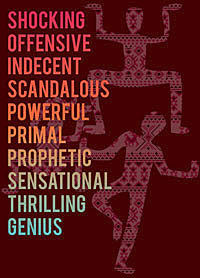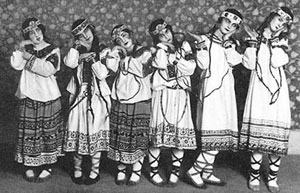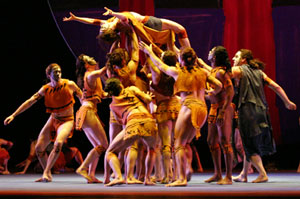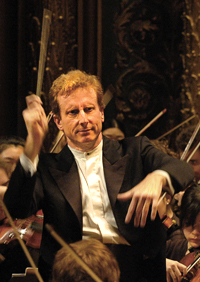Rite of Spring Centennial
NEC Philharmonia, Hugh Wolff Celebrate Pivotal Work of 20th century
NEC Philharmonia and Calderwood Conductor Hugh Wolff Celebrate Centennial of Stravinsky’s Rite of Spring, April 24, 2013
Jordan Hall Performance to be broadcast live on WGBH’s Classical New England, Replayed on Actual Date of Centenary
After Scandalous Premiere, Work Went On to Change Music History
John Heiss, Stravinsky’s “Pitch Doctor,” Gives Pre-concert Lecture, "Singing the Rite"
A thoroughly new vision, something never before seen, enthralling, persuasive, is suddenly there, a new kind of wildness, both un-art and art at the same time.— First person account of Rite of Spring Premiere, May 29, 1913 in Paris from Journey to the Abyss: The Diaries of Count Harry Kessler.
 New England Conservatory’s Philharmonia and Stanford and Norma Jean Calderwood Director of Orchestras Hugh Wolff will celebrate the centennial of Stravinsky’s epochal ballet, The Rite of Spring, April 24, 2013 at 8 pm in NEC’s Jordan Hall. First performed by Sergei Diaghilev’s Ballets Russes on May 29, 1913, the Rite combined the revolutionary music of Stravinsky, iconoclastic choreography by Vaslav Nijinsky, coolly controlled conducting by Pierre Monteux, and vividly primitivist décor by Nicholas Roerich. It was a succès de scandale, with the work provoking one of the most notorious riots in the annals of music history. It went on to become one of the pivotal works of 20th century composition.
New England Conservatory’s Philharmonia and Stanford and Norma Jean Calderwood Director of Orchestras Hugh Wolff will celebrate the centennial of Stravinsky’s epochal ballet, The Rite of Spring, April 24, 2013 at 8 pm in NEC’s Jordan Hall. First performed by Sergei Diaghilev’s Ballets Russes on May 29, 1913, the Rite combined the revolutionary music of Stravinsky, iconoclastic choreography by Vaslav Nijinsky, coolly controlled conducting by Pierre Monteux, and vividly primitivist décor by Nicholas Roerich. It was a succès de scandale, with the work provoking one of the most notorious riots in the annals of music history. It went on to become one of the pivotal works of 20th century composition.
There, for the expert eye, were all the makings of a scandal. A fashionable audience in décolletage, outfitted in pearls, egret headdresses, plumes of ostrich; and, side by side, with the tails and feathers, the jackets, headbands, and showy rags of that race of aesthetes who randomly acclaim the new in order to express their hatred of the loges…a thousand nuances of snobbery, super-snobbery, counter-snobbery… –Jean Cocteau
 Alongside the complete ballet, the NEC forces will perform Borodin’s Polovtsian Dances, which was one of the other works on the Ballets Russes’ 1913 program. The concert also includes Schumann’s Symphony No. 1 “Spring”, a considerably more domestic work that reflects the composer’s happiness in the first year of his marriage to Clara Wieck. NEC composer, conductor, flutist John Heiss will discuss The Rite of Spring, in a free pre-concert lecture, “Singing the Rite,” at 6:45 p.m. in Jordan Hall. Through recorded excerpts, piano examples, and singing by the audience, he will illustrate the revolutionary facets of the work, which became a pivotal work in the history of 20th century composition. With a lifetime of experience performing, studying, and lecturing on 20th century music behind him, Heiss was once referred to by Stravinsky as “the pitch doctor” for the acuteness of his musical ear.
Alongside the complete ballet, the NEC forces will perform Borodin’s Polovtsian Dances, which was one of the other works on the Ballets Russes’ 1913 program. The concert also includes Schumann’s Symphony No. 1 “Spring”, a considerably more domestic work that reflects the composer’s happiness in the first year of his marriage to Clara Wieck. NEC composer, conductor, flutist John Heiss will discuss The Rite of Spring, in a free pre-concert lecture, “Singing the Rite,” at 6:45 p.m. in Jordan Hall. Through recorded excerpts, piano examples, and singing by the audience, he will illustrate the revolutionary facets of the work, which became a pivotal work in the history of 20th century composition. With a lifetime of experience performing, studying, and lecturing on 20th century music behind him, Heiss was once referred to by Stravinsky as “the pitch doctor” for the acuteness of his musical ear.
In keeping with the anniversary observances of the Stravinsky work, WGBH Classical New England will broadcast the concert live on 99.5 FM, with commentary beginning at 7 pm and the complete performance at 8. Hosts for the program will be WGBH’s James David Jacobs and guest commentator Harlow Robinson, Matthews Distinguished University Professor at Northeastern University in Russian/Soviet and East European Cultural History, a biographer of Prokofiev, and a frequent contributor to the Boston Globe. Classical New England plans to rebroadcast the Rite performance on the actual date of the centennial, May 29.
The public…was from the beginning restless, laughing, whistling, making jokes. Here and there some stood up. Stravinsky, who sat with his wife behind us, raced outside like one possessed after scarcely five minutes. Suddenly a stentorian voice cried out from the gallery, ‘Okay, whores of the Sixteenth (the Sixteenth Arrondissement, that of the elegant world), are you going to shut up soon?!...At the same moment D’Annunzio and Debussy in Astruc’s loge got into a quarrel with a neighboring loge, screaming into their faces, ‘What a bunch of imbeciles!’…And above this crazy din there continued the storm of salvos of laughter and scornful clapping while the music raged and on the stage the dancers, without flinching, danced fervently in a prehistoric fashion… –Count Harry Kessler
 Although the Rite made a tumultuous entry into the world, its genius was soon being acknowledged. The first performance was met with catcalls and fisticuffs, and the initial reviews were mostly scathing. French critic Jacques Rivière, wrote, "It is a wreckage of the past, crawling with and eaten away by familiar and monstrous forms of life." Henri Quittard of Le Figaro, called the work "a laborious and puerile barbarity" and added "We are sorry to see an artist such as M. Stravinsky involve himself in this disconcerting adventure." On the other hand Gustav Linor, writing in the leading theatrical magazine Comoedia, thought the performance was “superb,” especially that of ballerina Maria Piltz. He dismissed the disturbances, while deplorable, as merely "a rowdy debate" between two ill-mannered factions. Within a few performances, however, public opposition (and heckling) began to subside and within a year, the Rite was being acclaimed by audiences. It also began to exert its influence over contemporary composers, including Bartok, Janacek and other eastern Europeans; Edgard Varèse; Aaron Copland; and Olivier Messaien; not to mention jazz artists like Charlie Parker.
Although the Rite made a tumultuous entry into the world, its genius was soon being acknowledged. The first performance was met with catcalls and fisticuffs, and the initial reviews were mostly scathing. French critic Jacques Rivière, wrote, "It is a wreckage of the past, crawling with and eaten away by familiar and monstrous forms of life." Henri Quittard of Le Figaro, called the work "a laborious and puerile barbarity" and added "We are sorry to see an artist such as M. Stravinsky involve himself in this disconcerting adventure." On the other hand Gustav Linor, writing in the leading theatrical magazine Comoedia, thought the performance was “superb,” especially that of ballerina Maria Piltz. He dismissed the disturbances, while deplorable, as merely "a rowdy debate" between two ill-mannered factions. Within a few performances, however, public opposition (and heckling) began to subside and within a year, the Rite was being acclaimed by audiences. It also began to exert its influence over contemporary composers, including Bartok, Janacek and other eastern Europeans; Edgard Varèse; Aaron Copland; and Olivier Messaien; not to mention jazz artists like Charlie Parker.
The Rite, whose first part ends with a stampede for full orchestra titled “Dance of the Earth,” prophesied a new type of popular art—lowdown yet sophisticated, smartly savage, style and muscle intertwined. It epitomized the “second avant-garde” in classical composition, the post-Debussy strain that sought to drag the art out of Faustian “novel spheres” and into the physical world. For much of the 19th century, music had been a theatre of the mind; now composers would create a music of the body.”—The Rest is Noise by Alex Ross
 NEC’s Philharmonia is the Conservatory’s senior most ensemble and is comprised of outstanding upperclass and graduate students. Besides performing in Jordan Hall, the orchestra has also appeared at Sanders Theatre in Cambridge and at Boston’s Symphony Hall. Calderwood conductor Hugh Wolff, who joined the NEC faculty in 2008, has brought the Conservatory's orchestral program to a new level of eminence. Formerly music director of the St. Paul Chamber Orchestra, Grant Park Music Festival, and Frankfurt Radio Symphony Orchestra, he has conducted many of the major orchestras around the world, including frequent appearances with the Boston Symphony Orchestra. Three times nominated for a Grammy, Wolff has an extensive discography on the Teldec label with the St. Paul Chamber Orchestra and London's Philharmonia Orchestra.
NEC’s Philharmonia is the Conservatory’s senior most ensemble and is comprised of outstanding upperclass and graduate students. Besides performing in Jordan Hall, the orchestra has also appeared at Sanders Theatre in Cambridge and at Boston’s Symphony Hall. Calderwood conductor Hugh Wolff, who joined the NEC faculty in 2008, has brought the Conservatory's orchestral program to a new level of eminence. Formerly music director of the St. Paul Chamber Orchestra, Grant Park Music Festival, and Frankfurt Radio Symphony Orchestra, he has conducted many of the major orchestras around the world, including frequent appearances with the Boston Symphony Orchestra. Three times nominated for a Grammy, Wolff has an extensive discography on the Teldec label with the St. Paul Chamber Orchestra and London's Philharmonia Orchestra.
NEC’s Rite of Spring performance is free and open to the public.
For further information, check the NEC Website or call the NEC Concert Line at 617-585-1122. NEC’s Jordan Hall, Brown Hall, Williams Hall and the Keller Room are located at 30 Gainsborough St., corner of Huntington Ave. St. Botolph Hall is located at 241 St. Botolph St. between Gainsborough and Mass Ave.
ABOUT NEW ENGLAND CONSERVATORY
Recognized nationally and internationally as a leader among music schools, New England Conservatory in Boston, MA offers rigorous training in an intimate, nurturing community to 720 undergraduate, graduate, and doctoral music students from around the world. Its faculty of 225 boasts internationally esteemed artist-teachers and scholars. Its alumni go on to fill orchestra chairs, concert hall stages, jazz clubs, recording studios, and arts management positions worldwide. Nearly half of the Boston Symphony Orchestra is composed of NEC trained musicians and faculty.
The oldest independent school of music in the United States, NEC was founded in 1867 by Eben Tourjee. Its curriculum is remarkable for its wide range of styles and traditions. On the college level, it features training in classical, jazz, contemporary improvisation, world and early music. Through its Preparatory School, School of Continuing Education, and Community Programs and Partnerships Program, it provides training and performance opportunities for children, pre-college students, adults, and seniors. Through its outreach projects, it allows young musicians to engage with non-traditional audiences in schools, hospitals, and nursing homes—thereby bringing pleasure to new listeners and enlarging the universe for classical music, jazz, and contemporary improvisation.
NEC presents more than 900 free concerts each year, many of them in Jordan Hall, its world- renowned, century-old, beautifully restored concert hall. These programs range from solo recitals to chamber music to orchestral programs to jazz, contemporary improvisation, and opera scenes. Every year, NEC’s opera studies department also presents two fully staged opera productions at the Cutler Majestic Theatre or Paramount Theatre in Boston.
NEC is co-founder and educational partner of From the Top, a weekly radio program that celebrates outstanding young classical musicians from the entire country. With its broadcast home in Jordan Hall, the show is now carried by National Public Radio and is heard on 250 stations throughout the United States.
Contact: Ellen Pfeifer
Senior Communications Specialist
New England Conservatory
290 Huntington Ave.
Boston, MA 02115
617-585-1143
Ellen.pfeifer@necmusic.edu
